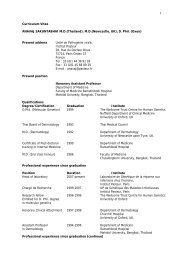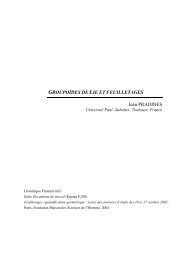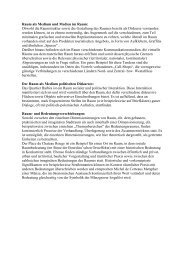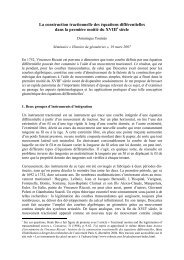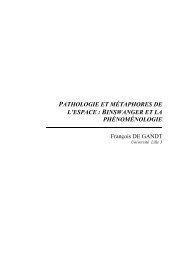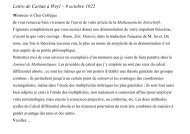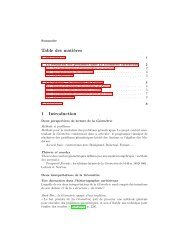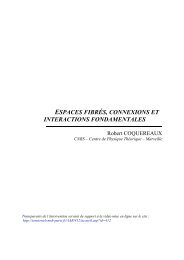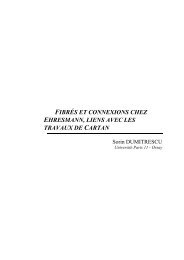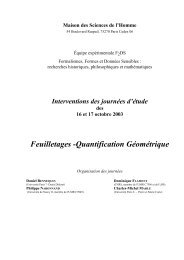Frigyes Riesz's approach to Hilbert's problem of continuity of space ...
Frigyes Riesz's approach to Hilbert's problem of continuity of space ...
Frigyes Riesz's approach to Hilbert's problem of continuity of space ...
Create successful ePaper yourself
Turn your PDF publications into a flip-book with our unique Google optimized e-Paper software.
CENTRE NATIONAL DE LA RECHERCHE SCIENTIFIQUEFONDATION MAISON DES SCIENCES DE L’HOMMESÉMINAIRE HISTOIRES DE GÉOMÉTRIESAnnée 2007ÉQUIPE F 2 DS & CENTRE CHARLES MORAZÉ54 bd Raspail 75006 Paris<strong>Frigyes</strong> <strong>Riesz's</strong> <strong>approach</strong> <strong>to</strong> Hilbert’s <strong>problem</strong> <strong>of</strong> <strong>continuity</strong><strong>of</strong> <strong>space</strong>. A chapter in the his<strong>to</strong>ry <strong>of</strong> general <strong>to</strong>pologyLaura RODRIGUEZ(Johannes Gutenberg – Universität, Mainz)Lundi 23 avril de 10h à 12h, Salle 214The question we will be dealing with is: <strong>to</strong> which extent is the concept <strong>of</strong> <strong>to</strong>pological<strong>space</strong> his<strong>to</strong>rically related with the concept <strong>of</strong> <strong>space</strong> in geometry? For some time itwas believed that Felix Hausdorff came <strong>to</strong> his definition <strong>of</strong> the concept <strong>of</strong> <strong>to</strong>pological<strong>space</strong> starting from Hilbert’s notion <strong>of</strong> the plane as a two-dimensional manifold 1 . Itwas Hermann Weyl, Hilbert’s best student, who set on the germ <strong>of</strong> this legend in anobituary dedicated <strong>to</strong> his master 2 . In recent years Erhard Scholz showed that thisassertion does not hold 3 . According <strong>to</strong> Scholz, Hausdorff developed his system <strong>of</strong>axioms for neighbourhoods when he was preparing a lecture on Riemanniansurfaces in the spring <strong>of</strong> the year 1912. As for Hilbert’s work on the foundations <strong>of</strong>geometry, Hausdorff had known it for sure since some years before 1912 and so hehad probably knew also Hilbert’s definition <strong>of</strong> the plane, and yet Scholz arguesconvincingly against any direct influence.In this way Scholz proved that Hilbert’s work on the foundations <strong>of</strong> geometry did notplay any essential role in the development <strong>of</strong> Hausdorff’s concept <strong>of</strong> <strong>to</strong>pological1 “With Hausdorff general <strong>to</strong>pology as it is unders<strong>to</strong>od <strong>to</strong>day starts. Taking up again the notion <strong>of</strong>neighbourhood, he knew how <strong>to</strong> choose, among the axioms <strong>of</strong> Hilbert on neighbourhoods in the plane,those that could give <strong>to</strong> his theory at the same time all the precision and the generality that weredesirable.” Nicolas Bourbaki. Elements <strong>of</strong> the His<strong>to</strong>ry <strong>of</strong> Mathematics. Berlin: Springer 1994 (OriginalFrench edition from 1984), p. 143. A similar statement can be found in a text by C. Chevalley and A.Weil called “Hermann Weyl (1885-1955)” that appeared in L’Enseignement Mathématique <strong>to</strong>me 3,fasc. 3 (1957) and was partially reprint in: Hermann Weyl Gesammelte Abhandlungen, K.Chandrasekharan (ed.), Heidelberg: Springer 1968,2 Hermann Weyl. David Hilbert and his mathematical work, Bulletin <strong>of</strong> AMS 50 (1944), 612-654. Herep. 638.3 Erhard Scholz. Logische Ordnungen im Chaos: Hausdorffs frühe Beiträge zur Mengenlehre. In:Egbert Brieskorn (Hrsg.) Felix Hausdorff zum Gedächtnis. Band I: Aspekte seines Werkes.Wiesbaden, Vieweg 1996
<strong>space</strong>. This is true for Hausdorff’s concept. But some years before Hausdorff’sdiscovery another mathematician was working on the development <strong>of</strong> an abstractpoint set theory based on a general concept named “mathematical continuum”, whichhappens <strong>to</strong> be very closely related <strong>to</strong> Hausdorff’s notion <strong>of</strong> <strong>to</strong>pological <strong>space</strong>. I amtalking <strong>of</strong> <strong>Frigyes</strong> Riesz, who 1906 was a young Hungarian mathematician that hadspent some years as a student and a research fellow in Göttingen and in Paris.Contrary <strong>to</strong> Hausdorff, Riesz did indeed attempt <strong>to</strong> contribute with his theory <strong>to</strong>Hilbert’s <strong>problem</strong> <strong>of</strong> the <strong>continuity</strong> <strong>of</strong> <strong>space</strong>. This is the s<strong>to</strong>ry I want <strong>to</strong> tell you: howRiesz’s abstract point set theory was connected with Hilbert’ work on the foundations<strong>of</strong> geometry.The aims <strong>of</strong> this talk are: To present Hilbert’s <strong>problem</strong> <strong>of</strong> <strong>continuity</strong> <strong>of</strong> <strong>space</strong> in the context <strong>of</strong> his workon the foundations <strong>of</strong> geometry To show how Riesz came <strong>to</strong> develop his notion <strong>of</strong> continuous <strong>space</strong> And <strong>to</strong> evaluate the role that Riesz’s ideas played in the further developmen<strong>to</strong>f mathematicsHilbert and the foundations <strong>of</strong> GeometryBy 1900 David Hilbert had emerged as the leading mathematician in Germany. In1899 Hilbert published his book The foundations <strong>of</strong> geometry, with which hesucceeded in building up the Euclidean geometry axiomatically and in a strictsystematic way, namely starting from a group <strong>of</strong> axioms and adding on subsequentlythe other four sets <strong>of</strong> axioms. The last group he added was the group <strong>of</strong> axioms <strong>of</strong><strong>continuity</strong>, showing in this way how far the geometry can be built up without anyassumptions <strong>of</strong> <strong>continuity</strong>.In 1902 Hilbert pursued an <strong>approach</strong> <strong>to</strong> the foundations <strong>of</strong> geometry entirely differentfrom the one followed in his book. The background was given by the so-calledRiemann-Helmholtz-Lie <strong>problem</strong> <strong>of</strong> <strong>space</strong>. From the standpoint <strong>of</strong> mechanicsHermann von Helmoltz had asked in 1868: in which <strong>of</strong> all those possible <strong>space</strong>sembraced by Riemann’s notion <strong>of</strong> a three dimensional manifold can the task befulfilled <strong>of</strong> describing the mobility <strong>of</strong> a solid. This is known as Helmholtz’s postulate <strong>of</strong>the free mobility <strong>of</strong> rigid bodies. Helmholtz succeeded in limiting the class <strong>of</strong> thosegeometries <strong>to</strong> the now so-called simply connected three-dimensional manifolds with
interest. Suffice it <strong>to</strong> say that its solution is known as the solution <strong>of</strong> Hilbert’s fifthmathematical <strong>problem</strong> and its importance is associated with the emergence <strong>of</strong> awhole new branch <strong>of</strong> mathematics: the theory <strong>of</strong> <strong>to</strong>pological groups.The question we will deal with is: how shall continuous <strong>space</strong> be defined? That iswhat I call “Hilbert’s <strong>problem</strong> <strong>of</strong> <strong>continuity</strong> <strong>of</strong> <strong>space</strong>”. How shall <strong>continuity</strong> becharacterised in order <strong>to</strong> provide a foundation on which geometry can be built up? SoHilbert’s fifth mathematical <strong>problem</strong> as well as his paper on the foundations <strong>of</strong>geometry from 1902 concerned the <strong>problem</strong> <strong>of</strong> <strong>continuity</strong> <strong>of</strong> <strong>space</strong>.In his paper from 1902 Hilbert explained his new <strong>approach</strong> <strong>to</strong> the foundations <strong>of</strong>geometry as follows [my translation]:There [in his book from 1899, LR] the axioms have been ordered in a way that the<strong>continuity</strong> is assumed after all the others axioms as the last one, so that the nextquestion follows up naturally: <strong>to</strong> what extent are the known theorems and results <strong>of</strong>the elementary geometry dependent <strong>of</strong> any assumptions <strong>of</strong> <strong>continuity</strong>?In the present paper the <strong>continuity</strong> is, on the contrary, assumed before any otheraxiom, from the very beginning, via the definition <strong>of</strong> the plane and that <strong>of</strong> the motion,so that the main task becomes <strong>to</strong> find out the least possible amount <strong>of</strong> assumptionsfrom which (and making extensively use <strong>of</strong> the <strong>continuity</strong>) the elemental objects <strong>of</strong>geometry (circle and line) can be obtained as well as those properties <strong>of</strong> them thatare necessary for building up the geometry. 6In his paper from 1902 “On the foundations <strong>of</strong> geometry” the <strong>space</strong> he studied wasthe two-dimensional one. He set the property <strong>of</strong> <strong>continuity</strong> from the beginning in thedefinition <strong>of</strong> the concept <strong>of</strong> the plane and in the definition <strong>of</strong> the notion <strong>of</strong> the motion.He <strong>to</strong>ok a <strong>to</strong>pological <strong>approach</strong>: he applied the methods <strong>of</strong> the point-set theory andthose <strong>of</strong> the analysis situs, From the point-set <strong>to</strong>pology he used elementary conceptslike those <strong>of</strong> open and closed set, but first <strong>of</strong> all he made extensively use <strong>of</strong> thenotion <strong>of</strong> convergence <strong>of</strong> a sequence in the plane and <strong>of</strong> the concept <strong>of</strong> accumulation6 „Dort ist eine solche Anordnung der Axiome befolgt worden, bei der die Stetigkeit hinter allen übrigenAxiomen an letzter Stelle gefordert wird, so daß dann naturgemäß die Frage in der Vordergrund tritt,inwieweit die bekannten Sätze und Schlußweisen der elementaren Geometrie von der Forderung derStetigkeit unabhängig sind. In der vorstehenden Untersuchung dagegen wird die Stetigkeit vor allenübrigen Axiomen an erster Stelle durch die Definition der Ebene und der Bewegung gefordert, so daßvielmehr die wichtigste Aufgabe darin bestand, das geringste Maß an Forderungen zu ermitteln, umaus demselben unter weitester Benutzung der Stetigkeit die elementaren Gebilde der Geometrie(Kreis und Gerade) und ihre zum Aufbau der Geometrie notwendigen Eigenschaften gewinnen zukönnen.“ D. Hilbert. “Über die Grundlagen der Geometrie“ Math. Ann. 56 (1902). Reprint in D. Hilbert.Grundlagen der Geometrie. Stuttgart: Teubner 1956 (8th ed.) 178-230. Quotation p. 230.
point in the plane. From the analysis situs the notion <strong>of</strong> Jordan curve and relatedresults like the theorem <strong>of</strong> Jordan and its inverse were going <strong>to</strong> play an essential role.Hilbert defined the plane as a two-dimensional manifold and by doing so he providedat the same time the most accurate definition for this concept <strong>of</strong> the time:According <strong>to</strong> Hilbert, the plane E is a point-set in which <strong>to</strong> each point p corresponds afamily <strong>of</strong> so-called neighbourhoods, formed by sets U ⊂ E containing p. The system<strong>of</strong> neighbourhoods fulfils six axioms. One <strong>of</strong> them postulates the existence <strong>of</strong> a one<strong>to</strong>-onemap on<strong>to</strong> a Jordan region, that means on<strong>to</strong> the inside <strong>of</strong> a closed Jordancurve in IR 2 . We call these maps coordinate functions. Furthermore, when aneighbourhood has two different images, then Hilbert demanded the correspondingcoordinate change <strong>to</strong> be continuous. That means: let f: UV and g: U W be twocoordinate functions <strong>of</strong> the same neighbourhood U on<strong>to</strong> the Jordan regions V and W,then the coordinate change g∗f -1 : VW is a continuous map <strong>of</strong> V on<strong>to</strong> W in IR 2 .The other four axioms state:1. For each Jordan domain V’⊂ V and containing the point ϕ(p), its counterimageϕ -1 (V’) is also a neighbourhood <strong>of</strong> p.2. A neighbourhood U <strong>of</strong> p containing the point q is also a neighbourhood <strong>of</strong> q.3. Each two neighbourhoods U and U’ <strong>of</strong> p contain another one U’’⊂U∩U’4. To any two points p, q <strong>of</strong> the plane there exists a common neighbourhood.Jordan regions: a basis <strong>of</strong> neighbourhoods for the planeThese are the neighbourhoods axioms from which it was once thought Hausdorffdeveloped his concept <strong>of</strong> <strong>to</strong>pological <strong>space</strong>. True is that the system <strong>of</strong> Jordan regionsHilbert used determine what in modern terms is called a neighbourhood basis for the<strong>to</strong>pology <strong>of</strong> the plane. So Hilbert provided the plane with a <strong>to</strong>pology but not havingthis notion he could not take full advantage <strong>of</strong> it. So for instance, he could notpostulate that the coordinate functions shall be continuous mappings from the planein<strong>to</strong> the Cartesian <strong>space</strong> IR 2 . He did not have the means for defining this notion.Transferring Can<strong>to</strong>r’s point-set theory <strong>of</strong> IR 2By defining the coordinate functions in that special way Hilbert introduced a series <strong>of</strong>concepts on the plane that depended <strong>of</strong> the natural <strong>to</strong>pology <strong>of</strong> the Cartesian planeIR 2 . He transferred point-set theoretical concepts valid for IR 2 on<strong>to</strong> the plane using
“The origin <strong>of</strong> the concept <strong>of</strong> <strong>space</strong>” from 1906 he wrote in the introduction a similarpassage but there he pointed directly <strong>to</strong> Lie’s and Hilbert’s notion <strong>of</strong> manifold.Back <strong>to</strong> the quotation <strong>of</strong> his letter: Riesz was criticizing the fact that Lie as well asHilbert had defined the notion <strong>of</strong> a n-dimensional manifold using the Cartesian <strong>space</strong>IR n and so they had defined it in terms <strong>of</strong> the real numbers. First <strong>of</strong> all he pointed <strong>to</strong>the consequences for the power <strong>of</strong> the set <strong>of</strong> points forming the manifold, namely thatit could not be bigger that the power <strong>of</strong> the set <strong>of</strong> real numbers. This Idea <strong>of</strong> Riesz isquite impressive then it means that he was <strong>approach</strong>ing the notion <strong>of</strong> <strong>continuity</strong> <strong>of</strong><strong>space</strong> from a quite general point <strong>of</strong> view. He continued his letter as follows:In my opinion the only essential features <strong>of</strong> IR n are the n-tuply ordering, thebeing dense everywhere and the <strong>continuity</strong> (the being perfect and connected)as these clearly appear in your definition <strong>of</strong> the plane although with thementioned limitation. According <strong>to</strong> this, the [<strong>space</strong>, LR] IR n is <strong>to</strong> be unders<strong>to</strong>odas a set <strong>of</strong> n-tuply order type.[Riesz <strong>to</strong> Hilbert, 18th November 1904]Thus, Riesz was searching an abstract characterisation <strong>of</strong> the Cartesian <strong>space</strong> IR n interms <strong>of</strong> the point-set theory and multiply order types. Following Can<strong>to</strong>r, hesuggested that a set shall be said <strong>to</strong> be continuous if it is perfect and connected 8 , butRiesz was thinking <strong>of</strong> course in applying the notions <strong>of</strong> perfect set and connected sethe had developed in his own theory <strong>of</strong> multiply order types --Can<strong>to</strong>r studied onlylinear order types.Why was Riesz suggesting an abstract characterisation <strong>of</strong> IR n in terms <strong>of</strong> point-settheoretical properties for order types? Because he thought it possible <strong>to</strong> give a moregeneral definition <strong>of</strong> the concept <strong>of</strong> n-dimensional manifold using those properties buthe did not want <strong>to</strong> have the limitations Hilbert did have as a consequence <strong>of</strong> thedirect relationship he postulated between the plane and the Cartesian <strong>space</strong> IR 2 .Apart from the already mentioned implications on the power, Riesz was concernedwith the <strong>problem</strong> <strong>of</strong> defining <strong>continuity</strong> in an abstract general way and independently<strong>of</strong> IR n in order <strong>to</strong> avoid using implicitly the point-set theoretical properties <strong>of</strong> this<strong>space</strong>.8 In Can<strong>to</strong>r’s theory a set is said <strong>to</strong> be perfect if it is closed and dense in itself; the set is said <strong>to</strong> beconnected if for every two points <strong>of</strong> the set and for every ε>0 there exists a finite subset <strong>of</strong> T <strong>of</strong> pointst 1 ,…,t n , such that the distances d(t 1 , t 2 ), d(t 2 , t 3 ), etc. are all smaller than ε.
M’ symbolizes the set <strong>of</strong> all accumulation points <strong>of</strong> the set M.X is a mathematical continuum, if for every element x <strong>of</strong> X and for every subset M<strong>of</strong> X holds: either x is not an accumulation point <strong>of</strong> M or if x is an accumulation poin<strong>to</strong>f M and the following conditions are satisfied:1. Let M be a finite set, then M has no accumulation point;2. Let x be an accumulation point <strong>of</strong> M and let M be a subset <strong>of</strong> N, then x is anaccumulation point <strong>of</strong> N <strong>to</strong>o;3. Let M be a subset <strong>of</strong> X that can be divided in<strong>to</strong> two disjoint subsets P and Q andlet x be an accumulation point <strong>of</strong> M, then x is an accumulation point <strong>of</strong> P or Q;4. Let x be an accumulation point <strong>of</strong> M and let y be a different element <strong>of</strong> x, thenthere exists a subset P <strong>of</strong> M, such that x is an accumulation point <strong>of</strong> P but y is notan accumulation point <strong>of</strong> P.This is the abstract concept <strong>of</strong> <strong>space</strong> that Riesz introduced in his paper „The origin <strong>of</strong>the concept <strong>of</strong> <strong>space</strong>“ and which is closely related with the modern concept <strong>of</strong><strong>to</strong>pological <strong>space</strong>. Examples <strong>of</strong> mathematical continua are the <strong>space</strong>s IR n with theirstandard concept <strong>of</strong> accumulation point, but also any set <strong>of</strong> functions whenconsidered as a metric <strong>space</strong>.Riesz used his concept <strong>of</strong> mathematical continuum as the basic condition that makespossible <strong>to</strong> investigate the properties <strong>of</strong> <strong>continuity</strong> <strong>of</strong> an abstract set. That means, the<strong>continuity</strong> <strong>of</strong> a set that is a mathematical continuum can be further characterized. Butif the set is not a mathematical continuum <strong>to</strong> investigate its <strong>continuity</strong> is nonsense.With regard <strong>to</strong> mathematical continua the interesting question is not if they arecontinuous but how good their <strong>continuity</strong> structure is.Riesz demanded as the basic property <strong>space</strong> <strong>to</strong> be a mathematical continuum. Forthe further characterization <strong>of</strong> its <strong>continuity</strong> he introduced the concept <strong>of</strong> similarlycondensed (ähnlich verdichtet'). According <strong>to</strong> Riesz two sets are similarly condensed,if their structures <strong>of</strong> mathematical continua are isomorphic <strong>to</strong> each other. Besides hedefined the concept <strong>of</strong> condensation type (Verdichtungstypus) as „the <strong>to</strong>tality <strong>of</strong> allproperties common <strong>to</strong> all mathematical continua, which are similarly condensed <strong>to</strong>each other”. Furthermore he defined a general concept <strong>of</strong> neighbourhood based onthe notion <strong>of</strong> accumulation point. Applying these theoretical <strong>to</strong>ols Riesz chosefollowing characterization <strong>of</strong> continuous geometrical <strong>space</strong>:
In this way, one achieves a characterisation <strong>of</strong> <strong>space</strong> as a connectedmathematical continuum, <strong>of</strong> which every element has a neighbourhood, which,considered as an independent continuum, has the same condensation type asthe three-dimensional <strong>space</strong> <strong>of</strong> numbers. So one arrives at Hilbert‘s moregeneral conception <strong>of</strong> continuous <strong>space</strong>. (Riesz 1907, 349)That means: for Riesz the <strong>space</strong> is a connected mathematical continuum locallysimilarly condensed as IR 3 .His<strong>to</strong>rical meaning <strong>of</strong> Riesz’s contribution <strong>to</strong> Hilbert’s<strong>problem</strong> <strong>of</strong> <strong>continuity</strong> <strong>of</strong> <strong>space</strong>Now the question I would like <strong>to</strong> discuss is: what happened with this contribution <strong>of</strong>Riesz?With relation <strong>to</strong> the research work on the foundations <strong>of</strong> geometry: there were not anyreception <strong>of</strong> these Riesz’ ideas, as far as I know. There are several fac<strong>to</strong>rs that mighthave played a negative role. First: the task set by Hilbert drew more urgently theattention <strong>to</strong> the <strong>problem</strong> <strong>of</strong> getting rid <strong>of</strong> Lie’s assumptions <strong>of</strong> differentiability in theconcept <strong>of</strong> group <strong>of</strong> continuous transformations. On the other hand, Riesz presentedhis ideas as a part <strong>of</strong> a more ambitious project that went beyond the frame <strong>of</strong> puremathematics. A third fac<strong>to</strong>r might be the fact that the paper appeared in anHungarian Journal and not in a Journal <strong>of</strong> the Rang <strong>of</strong> the Mathematischen Annalen.The his<strong>to</strong>rical meaning <strong>of</strong> Riesz’ theory <strong>of</strong> mathematical continuum is related with thehis<strong>to</strong>ry <strong>of</strong> general <strong>to</strong>pology and functional analysis. Riesz’ general concept <strong>of</strong>mathematical continuum was the basic concept with which he set out <strong>to</strong> develop anabstract point set-theory. This development preceded Felix Hausdorff’s theory <strong>of</strong><strong>to</strong>pological <strong>space</strong>. When Hausdorff’s theory appeared in 1914 Riesz’ ideas were notdiscarded. On the contrary, until the beginning <strong>of</strong> the 1920ies Riesz’ conceptscompeted with those from Hausdorff in the work <strong>of</strong> young set-theoreticalmathematicians. Since 1911 there were different efforts <strong>to</strong> develop an abstract pointset-theory based on Riesz’ concept <strong>of</strong> the mathematical continuum. They <strong>to</strong>ok placein the USA in the work <strong>of</strong> Ralph Root, Edward Chittenden and Robert Lee Moore.Once Hausdorff introduced his concept <strong>of</strong> <strong>to</strong>pological <strong>space</strong> in 1914 other pioneers <strong>of</strong>the general <strong>to</strong>pology like Maurice Fréchet and Leopold Vie<strong>to</strong>ris considered bothRiesz’ as well as Hausdorff’s ideas as a starting point. That means: Riesz’ ideas were
considered as a serious alternative <strong>to</strong> Hausdorff’s theory <strong>of</strong> <strong>to</strong>pological <strong>space</strong> at leastuntil the beginning <strong>of</strong> the 1920ies, something, it seems <strong>to</strong> me, which has not beenproperly acknowledged in most <strong>of</strong> the studies on the his<strong>to</strong>ry <strong>of</strong> general <strong>to</strong>pology. Infact, it can be said that the his<strong>to</strong>ry <strong>of</strong> Riesz’ concept <strong>of</strong> mathematical continuumconstitutes a chapter in the his<strong>to</strong>ry <strong>of</strong> both modern branches <strong>of</strong> mathematics: general<strong>to</strong>pology and functional analysis.



